The ‘Garden State’ of New Jersey is an excellent place to be a birder. With the Appalachian mountains cutting across the state as well as ridges, valleys, and even ancient rock formations in New England you’ve got a recipe for Avian diversity that has to be seen to be believed. Today we’ll tell you about the popular backyard birds of New Jersey and give you the inside scoop on what they like to eat, where they like to hide, and even where you can go if you are looking to see them outside of your neighborhood. As it turns out, you’ve got quite a lot of birds that you can look for in New Jersey as you are about to see.
3 Categories – 480 Birds
That’s right, New Jersey is home to more than 480 species of birds throughout the year. That’s quite a lot of feathered friends for you to look for and unfortunately way too much for us to detail in the space that we’ve got today. That said, we’re going to give you a sampling of local birds divided up seasonally like this:
- Year-round Resident birds
- Birds of Spring, Summer, and Early Fall
- Fall and Winter Birds
This way you’ll know when to look for these birds and we’ll also tell you where to find them just in case they don’t come to visit your backyard right away. Let’s get started with the year-round resident birds of New Jersey.
New Jersey’s Year-round Resident birds
Our first birds to introduce are the year-round resident birds. These New Jersey birds may be found at any time of the year and are just waiting to be spotted. Be sure to see if you can spot one of these year-round resident birds this year:
- American Robin
- Downy Woodpecker
- American Goldfinch
- Tufted Titmouse
- Northern Cardinal
American Robin – Turdus migratorius
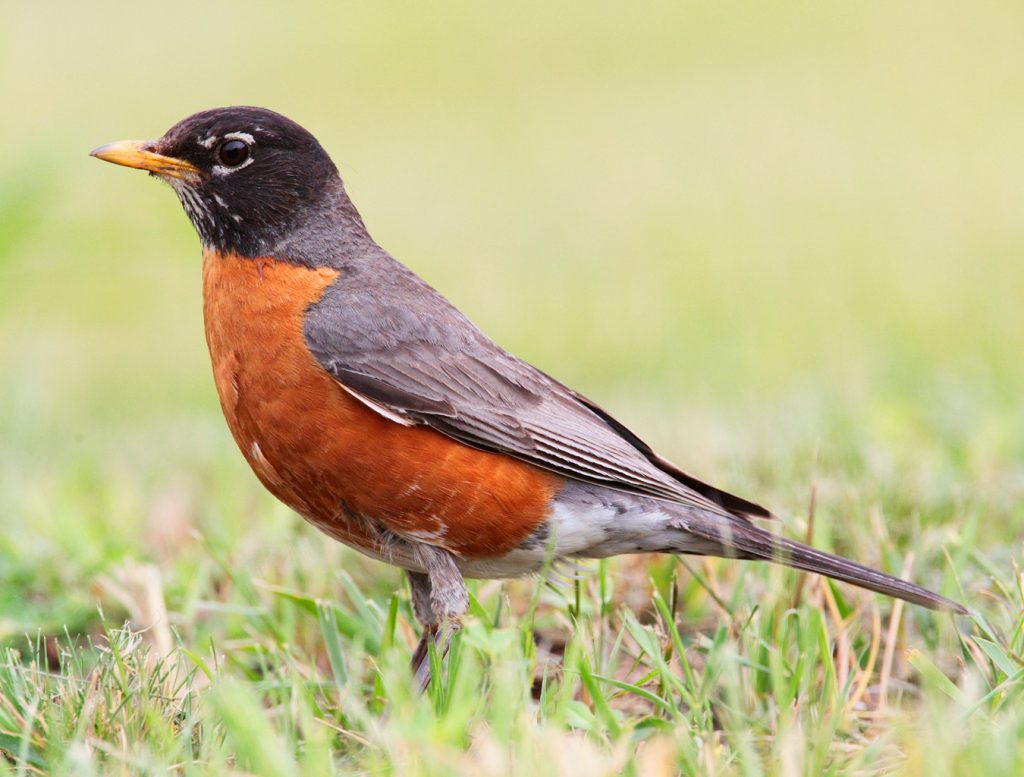
Coloration and Markings: American Robins have gray backs, with medium length gray wings and long, gray tails, which have white coloration on the undersides coming from the rump. These birds have an underbelly and breast which is tangerine-orange in color and facially, these birds have black heads with ‘broken’, white eyerings surrounding each eye. These birds have medium length, slightly curved yellow bills.
Size: These birds measure in at 7.9 -11 inches from head to tail and have a wingspan of 12.2 – 15.8 inches wide.
Habitat: Robins may be found in a number of different environments, such as pastures, parks, fields, and the woods (especially Pine forests). These bold birds are more than happy to visit a well-stocked feeder as well, so be sure to leave a little something out for them.
Diet: The birds love fruit so raisins and even cranberries are much appreciated, but you may also get their attention with mealworms, suet, and Black Oil Sunflower seeds.
Downy Woodpecker – Picoides pubescens
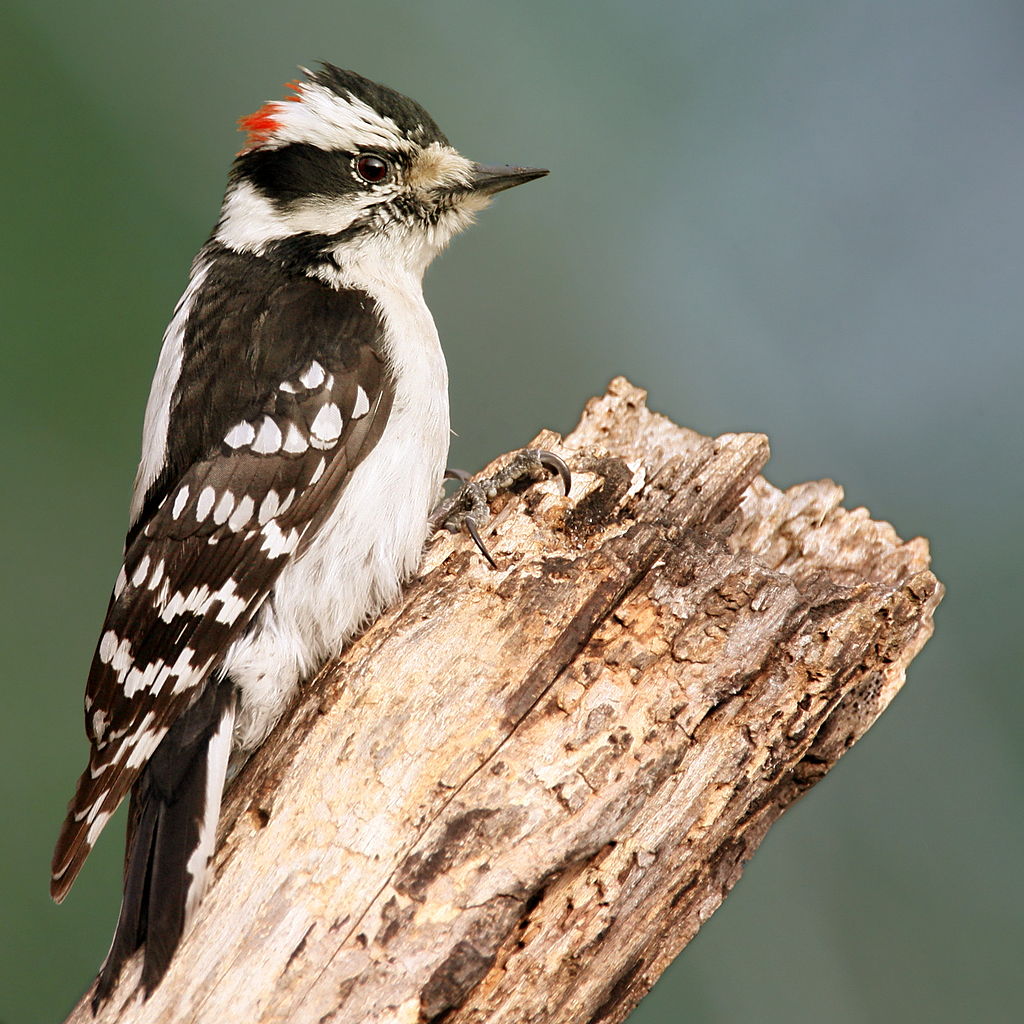
Coloration and Markings: The smallest North American Woodpeckers, Downies are beautiful and quite easy to identify. These birds have a wide, white stripe going down their back, as well as short and notched black tails with medium-length black wings. The wings bear a checkerboard pattern of stripes made from white spots, which starts just below shoulder level and goes down to the tips. The underside of the notched tails will be snowy=white as well, and this color carries up through the underbelly and the breast. Facially, these birds have white faces with a black mustache line, a black ‘bandit’s mask’, and a black cap which goes down to the back of the mask. With males, the cap will terminate at a red spot just above the mask but this cap will be completely black for female Downies. These birds have thin, medium-length, and almost tubular black bills.
Size: These birds measure in at 5.5 – 6.7 inches in length and have wingspans of 9.8 to 11.8 inches wide.
Habitat: These birds love the open woods and are especially fond of deciduous regions, where you can find if there is thick brush or high weeds nearby. They are also quite fond of orchards, parks, and backyards with well-stocked feeders.
Diet: Downies love a number of different foods, such as suet, peanut butter, Black Oil Sunflower seeds, and even an occasional sip of the sugar water in your hummingbird feeder!
American Goldfinch – Spinus tristis

Coloration and Markings: Male American Goldfinches have bright yellow backs, with Long, black wings and short, notched black tails. The wings will have 2 white wingbards present, as well as a score of vertical, white markings towards the inner-center of the wing. These markings are also present on the tails as well. These birds have white rumps but the underbelly and breast of this bird are bright yellow and facially, these birds as yellow as well with the exception of a small, black half-cap at the forehead and a medium-length, conical, and orange bill. Females Goldfinches will have an olive coloration, instead of the black, and their yellows will not be as bright. In the winter, both genders will molt their yellows and trade them in for brown plumage, though you can still just make out their distinctive wingbars.
Size: These birds measure in at 4.3 – 5.1 inches in length and have wingspans of 7.5 – 8.7 inches wide.
Habitat: Goldfinches love overgrown weeds and grasses, especially in areas which are prone to flooding. They are quite fond of ranging out, however, and you can see them sometimes on the sides of roads, in gardens, parks, and in backyards as well.
Diet: Nyjer thistle and Black Oil Sunflower seeds are both favorites of the American Goldfinch and might just lure them into your backyard for a closer look.
Tufted Titmouse – Baeolophus bicolor
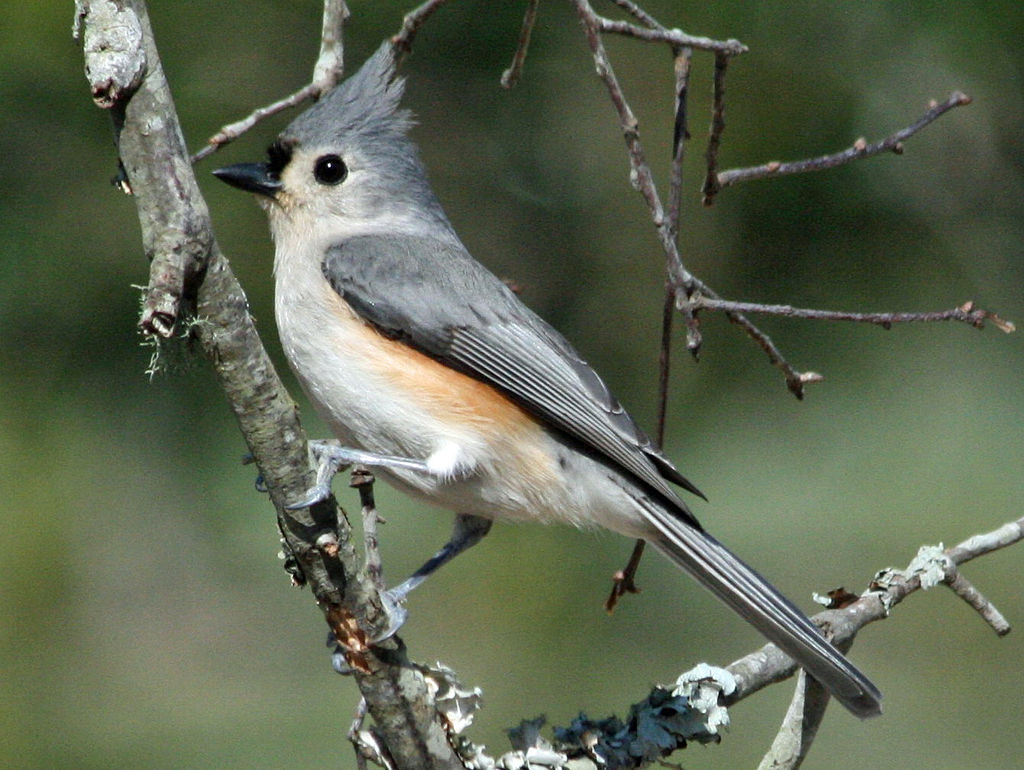
Coloration and Markings: The Tufted Titmouse has a grayish-blue back with small, grayish blue wings and long, grayish blue tails. They have a white breast and underbelly, with a faint flanking of peach color just underneath the wings, and facially, these birds are mostly white, with beautiful little blue crests and some blue coloration framing the eye on the upper portion of the face. Finally, these birds have a distinctive black spot just above their small, triangular black bills.
Size: These birds measure in at 5.5 – 6.3 inches from tip to tail and have wingspans of 7.9 to 10.2 inches wide.
Habitat: Titmice may be found in evergreen and deciduous woods, especially at lower elevations, but they also range out to visit parks, orchards, and backyards with well-stocked feeders.
Diet: Suet, peanuts, and Black Oil Sunflower seeds are 3 favorites of Tufted Titmice. Be sure to leave one or all of these out and you might just get a feeder visit.
Northern Cardinal – Cardinalis cardinalis
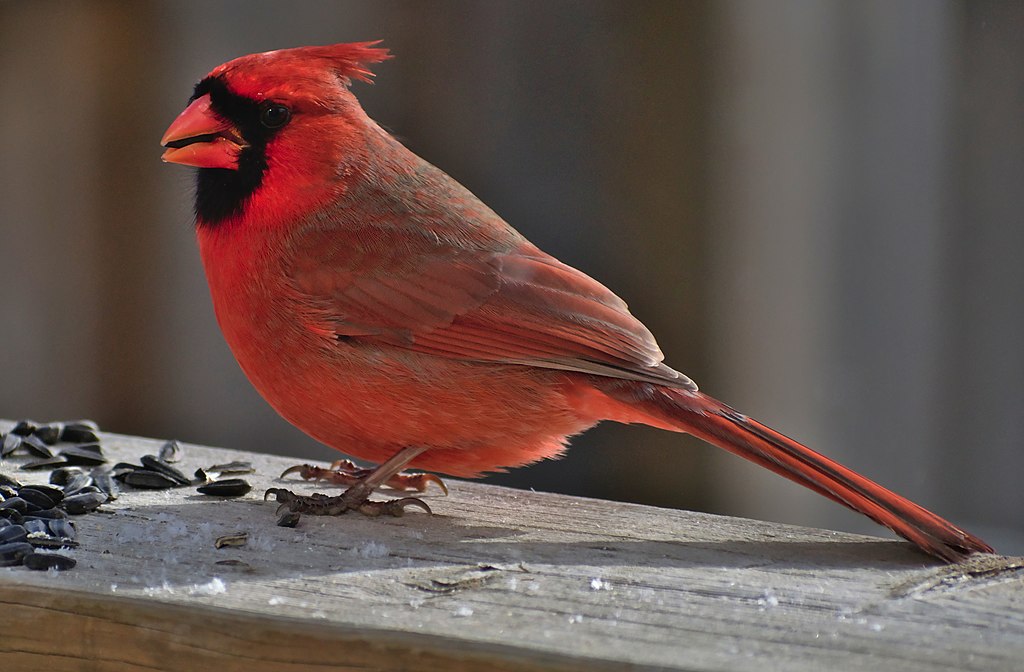
Coloration and Markings: Male Cardinals are one of the easiest birds to identify, with their striking, red plumage taking up most of their bodies. They have medium-length, red wings and long, red tails and facially, these birds have a majestic red crest that you can’t miss. The deviation in color on the male Robin comes from its distinctive black mask, which covers the eyes and then pulls sharply down into the chin, and these birds have short, wide, conical reddish-orange bills. Female Cardinals will have a lovely brown overall plumage, hints of red throughout.
Size: These birds measure in at 8.3 – 9.1 inches in length and have wingspans of 9.8 to 12. Inches in width.
Habitat: Cardinals love areas where the brush and bramble are dense but these bold, red birds are quite at home in residential areas as well, where they are common visitors at woodlots, parks, and in backyards with well-stocked feeders.
Diet: Cardinals love suet, Black Oil Sunflower seeds, peanuts, and Nyjer thistle. Put out one or more of these and you might just get their attentions.
New Jersey’s Birds of Spring, Summer, and Early Fall
Spring gets an early start in New Jersey and with it comes the call of the Spring Peeper frogs as well as the blooming of Violets, Blue and Yellow Iris, and more! Everything gets quite colorful and a number of birds start arriving to make the most of it. See if you can spot one of these birds during spring, summer, ad early fall:
- Indigo Bunting
- Eastern Kingbird
- House Finch
- Barn Swallow
- Tree Swallow
Indigo Bunting – Passerina cyanea

Coloration and Markings: Male Indigo Buntings are quite striking and easy to identify, being completely indigo blue with the occasion of some gray that may be seen on the edges of their wings when they are molting. They have short wings and a tiny bit of black just in front of the eyes. These birds have short, stout, and stocky silver bills and immature males will present as a mix of patchy blues and browns. Females, by contrast, will be mostly brown with touches of indigo blue in their wings as well as a some white displayed at the throat and some dim streaking at the breast.
Size: These little beauties measure in at 4.7 – 5.1 inches in length and have wingspans of 7.5 to 8.7 inches wide.
Habitat: Indigo Buntings are birds of brushes, brambles, thickets and thorns… they prefer to sing high up in the trees they tend to forage much lower on the ground, so look for them there if you don’t hear them and you might just spot an Indigo Bunting.
Diet: Nyjer thistle and small, hulled Black Oil Sunflower seeds are favorites of Indigo Buntings and you might have some luck with dried or live mealworms.
Eastern Kingbird – Tyrannus tyrannus
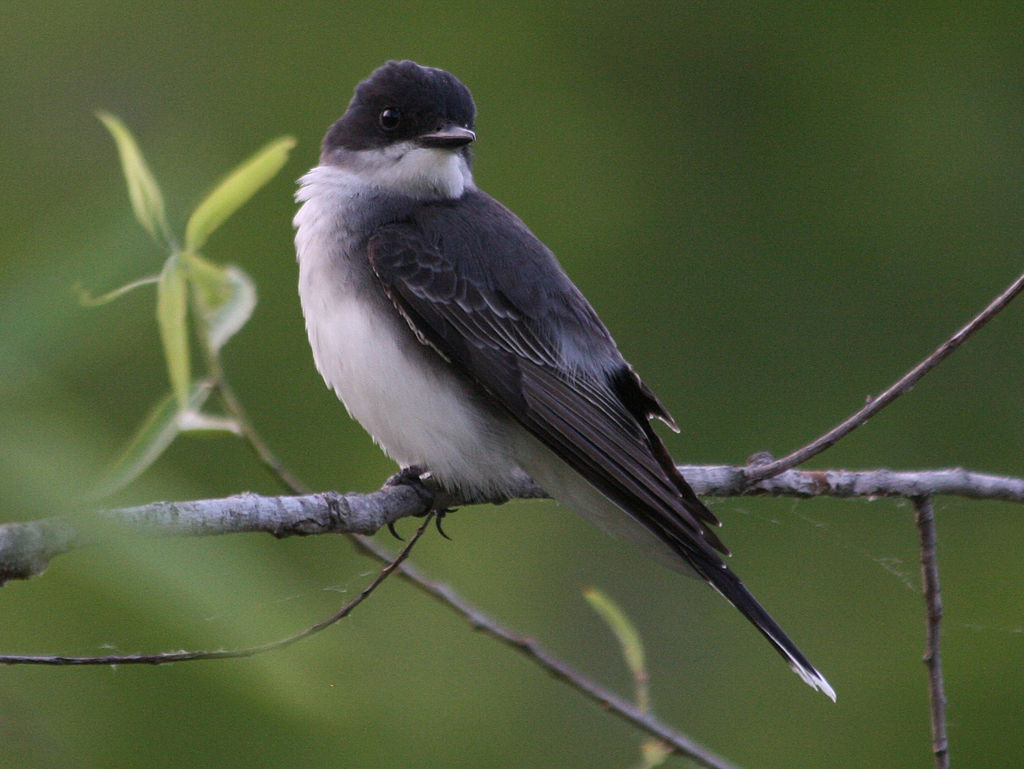
Coloration and Markings: Eastern Kingbirds have blackish-gray backs, with medium-length wings and squarish, white-tipped tails of the same color. The underbelly and breast of this bird is white, which carries up into the face to fill in the cheeks and chin, with black taking up the rest of the face in a ‘hooded’ effect. These birds have stout, straight, and medium-length black bills.
Size: These birds measure in at 7.5 – 9.1 inches in length and have wingspans of 12 to 15 inches wide.
Habitat: Kingbirds love open areas, such as fields, pastures, and the forest’s edge. They are especially fond of water, so look for them near rivers and streams for best results.
Diet: While primarily insectivorous, these birds do like to supplement their diets with berries, so some chopped cherries or whole blackberries in your feeder might just get their attentions. They are a bit shy, however, so you might have better luck if you have fruiting trees and bushes in your backyard.
House Finch – Haemorhous mexicanus
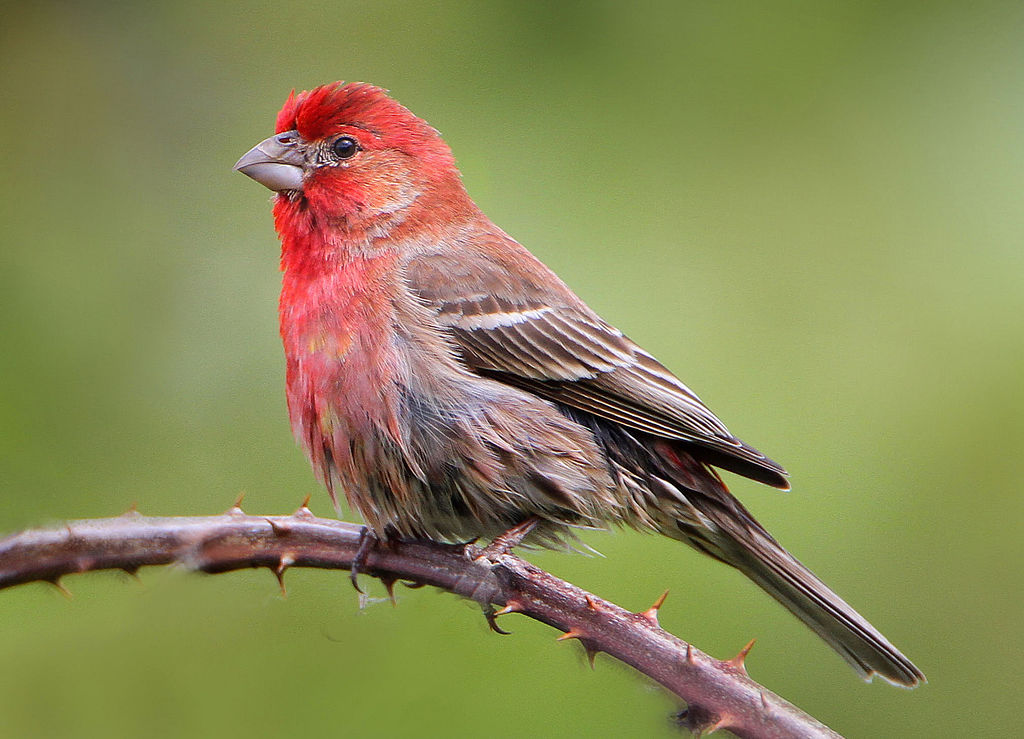
Coloration and Markings: Male House Finches have streaky brown or gray backs, with short, grayish wings which have an assortment of vertical black lines as wll as 2 white wingbars on each wing. They have medium-length grayish tails with white out the outer edges and the underbelly of this bird is white with black or brown streaking that is also present just under the wings. The breast of this bird, however, will be a rosy hue that starts just at the top of the underbelly and carries up the breast and into the Finch’s face. The males have a gray eyestripe that crosses the eyes and curves around to frame the cheek, as well as some gray towards the back of the head, but the majority of the face is rosy-red or raspberry in color. Females, by contrast, will lack the red but instead be a grayish brown overall color. They also have some blurry streaking at the breast and underbelly and lack the distinct facial markings of the male. These birds have short, stout, and slightly curved silver bills.
Size: These birds measure in at 5.1 – 5.5 inches in length and have wingspans of 7.9 to 9.8 inches wide.
Habitat: House Finches are tiny birds with a wide range of habitats. You can spot them in deserts, chaparral, meadows, and grassy or weedy fields. They are also not so shy about inhabited areas, so you can spot them in parks and residential backyards as well.
Diet: Nyjer thistle works but you will have the best luck attracting House Finches with small, hulled Black Oil Sunflower seeds. They just can’t seem to eat enough!
Barn Swallow – Hirundo rustica
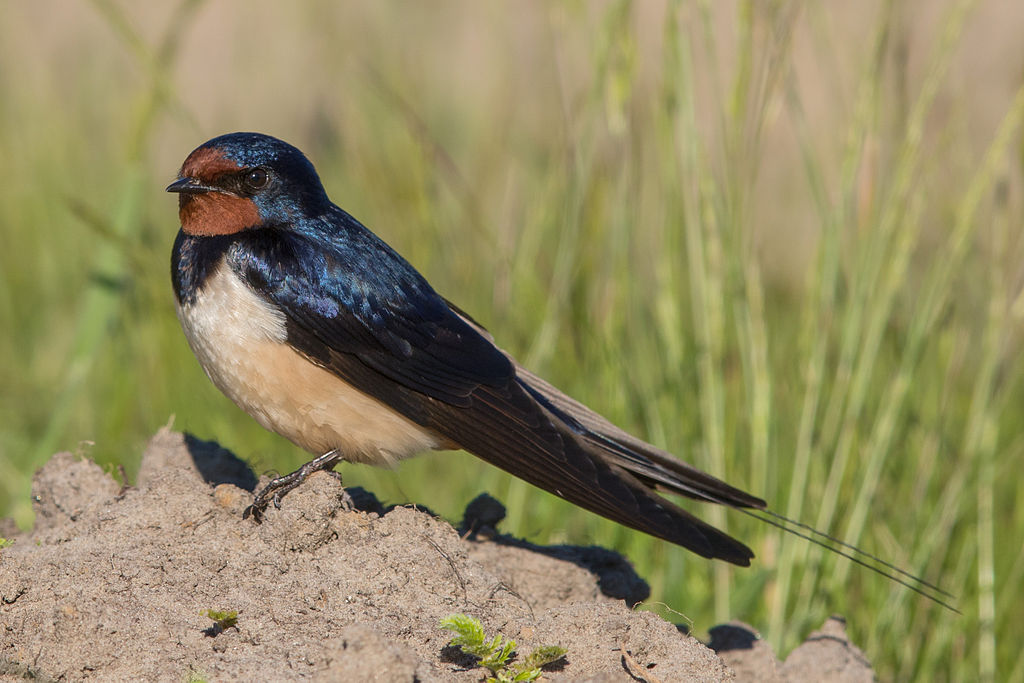
Coloration and Markings: Barn Swallows have quite the distinctive plumage, looking like nothing more than little superheroes. They have backs which are a deep, dark blue, with long, pointed blue wings and long, deeply forked tails which display a row of white spots that you can only see when the bird is in flight. A small amount of white is also visible at the upper tip of the shoulders of this bird and their underbelly and breast will be a cinnamon orange color. At the top of the breast you can see a v-shape of blue ‘backpack lines’ that give the wings the appearance of a cape and facially, this orange takes up most of the lower face, stopping just under the blue cheeks to frame them nicely and protruding a bit just above the bill. Above the bill the rest of the head is blue, with the exception of a diamond-shaped black mask. These birds have small and sharp-looking triangular black bills.
Size: These birds measure in at 5.9 – 7.5 inches from tip to tail and have wingspans of 11.4 to 12.6 inches wide.
Habitat: These Swallows love open areas, such as fields or meadows, and especially when there is water nearby. True to their namesake, they do like nesting in enclosed areas such as barns, woodsheds, and bridges.
Diet: These birds are primarily insectivorous but you might have some luck with live mealworms, as well as Nyjer thistle and small berries, such as blueberries or blackberries.
Tree Swallow – Tachycineta bicolor
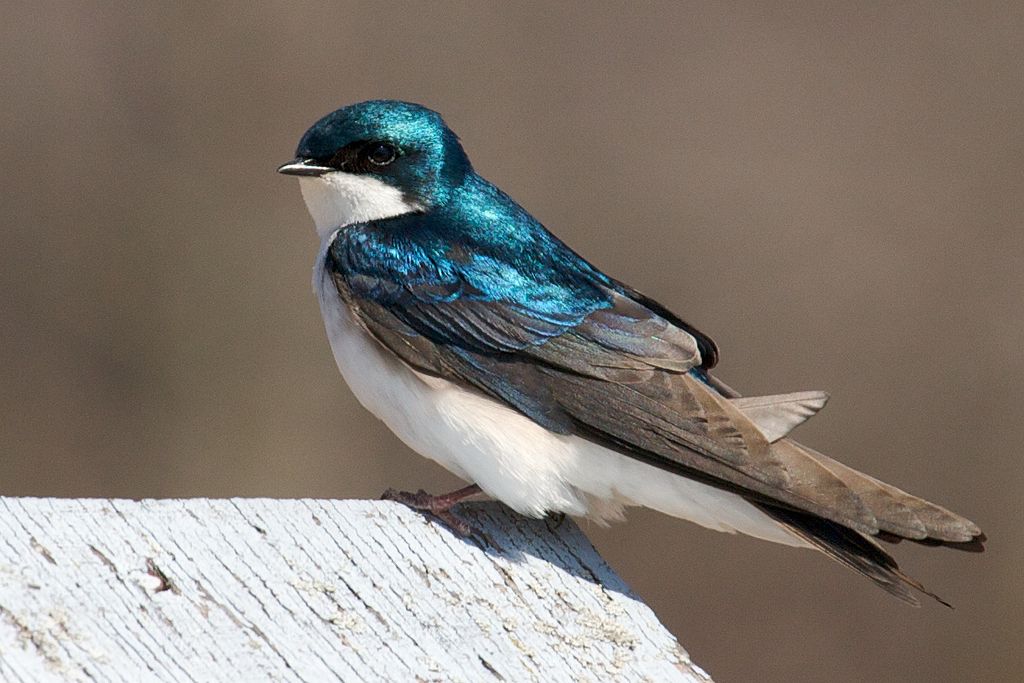
Coloration and Markings: Male Tree Swallows have bluish-green backs with long wings which are bluish-green at the shoulders and tend to be gray below. They have short, gray tails and their underbelly and breast are a bright, snowy white. This extends up ito the lower face, framing the cheeks and filling the chin, with the upper portions of the head being bluish-green with the exception of a black mask and the birds tiny, slightly curved black bill. Females will have more browns in their upper body as well as duller colors and they will sometimes have a brownish band at the breast, which is also often present in juveniles of both genders.
Size: These birds measure in at 4.7 – 5.9 inches in length and have wingspans of 11.8 to 13.8 inches wide.
Habitat: Nesting often in the hollows of trees, these birds love open, wooded areas and are especially fond of places close to streams and even wetlands. They may also be found in overgrown, grassy fields, especially in areas prone to flooding.
Diet: While Tree Swallows almost never visit feeders, you might have a little luck attracting them to your yard with a nesting box.
New Jersey’s Fall and Winter Birds
With average lows of 21 degrees Fahrenheit, New Jersey winters certainly make sure that you won’t forget to wear your coat outside. Throughout the chill a number of birds are foraging and playing outside and they could really use your support, so stock up your feeder and leave a heated birdbath out if you’ve got one for one of these or the many other birds out in the Jersey winter:
- Mourning Dove
- Dark-eyed Junco
- Carolina Chickadee
- American Crow
- House Sparrow
Mourning Dove – Zenaida macroura
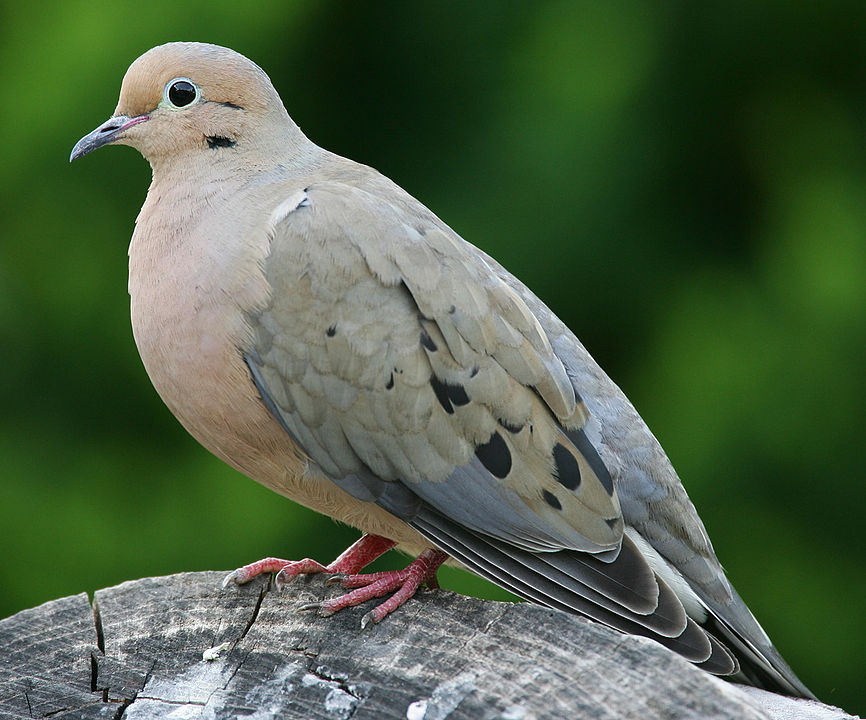
Coloration and Markings: Mourning Doves tent o be a grayish-tan overall, with grayish backs and medium-length, broad wings which have a heavy concentration of tan coloration with some distinctive black spots that are hard to miss. They have long, pointy tails, which are unique with this bird among other North American Dove, and the underbelly and breast of this bird are white with a heavy dose of creamy tan coloration. Facially, these birds are gray and extremely tan in color, with a small, but noticeable white eyering and a thin, medium-length black bill.
Size: These Doves measure in at 9.1 – 13.4 inches in length and have wingspans of approximately 17.7 inches in width.
Habitat: These are city birds, eschewing the woods and preferring to spend their time on fences, phone lines, and sidewalks around the city. You can also find them in fields but this is about as close to the woods as these little urbanized birds like to go.
Diet: Nyjer thistle, Safflower, and Black Oil Sunflower seeds are the best foods for attracting the attentions of the Mourning Dove.
Dark-eyed Junco – Junco hyemalis

Coloration and Markings: Dark-eyed Juncos come in a number of regional varieties but the most commonly spotted will have grayish brown backs, with medium-length grayish wings and long, gray tails which are white on the undersides. The underbelly and breast of this bird are white with a heavy flanking of gray at the sides which gives the bird the appearance of having been dipped in white paint. The top 2/3 being gray and the bottom 1/3 seeming to be evenly white when the bird is viewed at rest. Facially, these birds are gray with stout, medium-length pink bills.
Size: These birds measure in at 5.5 – 6.3 inches from tip to tail and have wingspans of 7.1 to 9.8 inches wide.
Habitat: Dark-eyed Juncos love coniferous and mixed coniferous woods but they may also be found in fields, roadsides, parks, and backyards with well-stocked feeders.
Diet: Juncos love cracked corn, White Proso millet, and Black Oil Sunflower seeds. Add 1 or more to your feeder and you might just get this bird’s attentions.
Carolina Chickadee – Poecile carolinensis
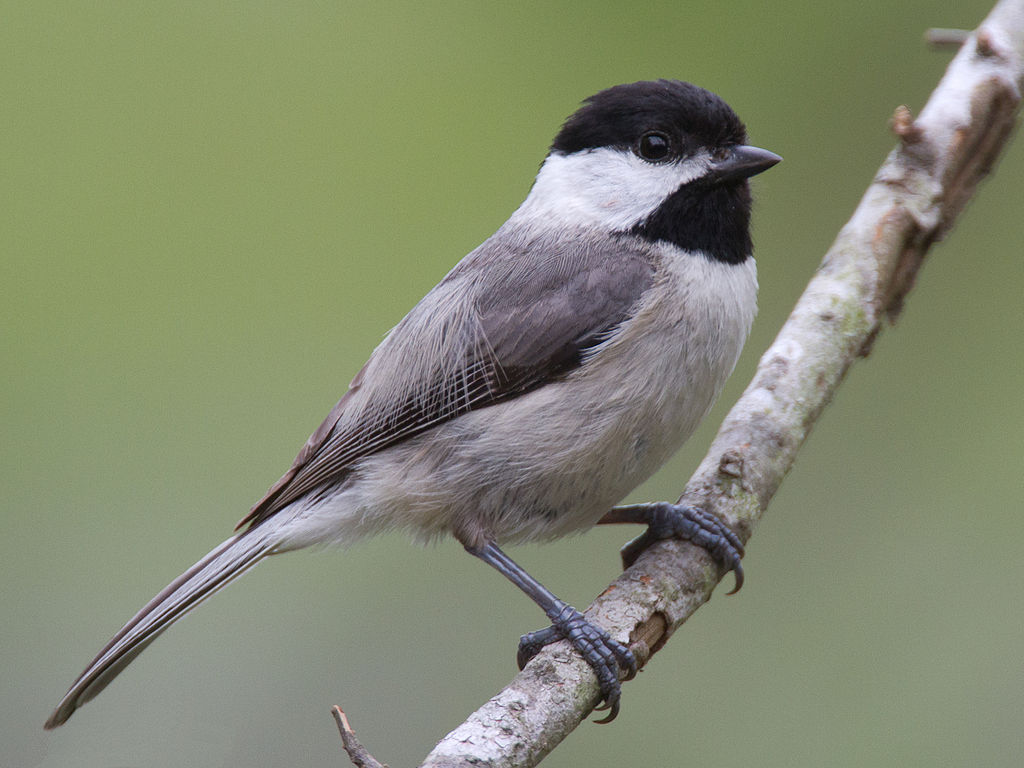
Coloration and Markings: Carolina Chickadees are identifiable at a glance, with soft, gray backs and short, gray wings, along with long, gray tails and a ‘dirty-white’ underbelly and breast. Facially, these birds have black bibs and large, black caps which settle at mid-eye level and leave the remaining center of the face a snowy white. Their distinct faces make them quite hard to miss! These birds have short, triangular black bills.
Size: The lovely, diminutive birds measure in at 3.9 – 4.7 inches in length with wingspans of 5.9 to 7,9 inches wide.
Habitat: These are birds of two worlds, frequenting the forest and the city in an almost equal frequency. Look for them where you find large trees, in parks, backyards, or at the forest’s edge.
Diet: Chickadees love suet, especially when it’s laced with peanut butter. Leaving this treat out is a great way to increases your chances of luring a Carolina Chickadee to your backyard feeder.
American Crow – Corvus brachyrhynchos

Coloration and Markings: American Crows are completely black, even on their legs and feet, and they have large, rounded wings and short, but wide squared-off tails. These birds have large, thick, and straight bills which have a noticeable curvature on the upper bill. If the Crow looks a little brown, don’t worry, that just means that your clever friend is molting into a fresh set of feathers. While they are common birds, they are great fun to watch, so be sure to leave a little something out for these little Einsteins. They are well worth your while.
Size: These birds are a bit on the large side, measuring in at 15.8 – 20.9 inches in length and having wingspans of 33.5 to 39.4 inches wide!
Habitat: While they may be found in the deep forest, Crows are more often found at the forest’s edge, fields, or simply spending time around the city. They do dig around in trash when they find them so be sure that your garbage can is secured if you don’t want your local crows to dig around in there.
Diet: Crows love suet but they might eat too much of it, leaving your other Avian visitors a bit disappointed. To keep them out you can sometimes try a more caged/secure suet feeder and leave out some delicious wheat and oats instead. Crows like fruit as well so you might leave a little out for these often-underappreciated clever birds.
House Sparrow – Passer domesticus

Coloration and Markings: Male House Sparrows have warm, brown backs with black streaks as well as short wings and medium-length, perky tails of the same color. The undersides of the tail, as well as the underbelly and breast of this bird are a ‘dirty’ mix of grays and whites and you can see some black at the top of the breast coming down from the bird’s bib. Facially, this bird has a black chin, white cheeks and white at the base of the neck going all the way to the back of the head, as well as a warm, brown eyeline that starts as black in front of the eyes but turns brown as it goes through them to curve around beautifully as it frames the cheek. The top of the birds head has a steely gray stripe and this bird has a stout, medium-length and slightly curved black bill. Females will have plainer colors, with their underbelly and breast being more of a grayish-brown and their back stripes will be more pronounced.
Size: These birds measure in at 5.9 – 6.7 inches from head to tail and have wingspans of 7.5 to 9.8 inches wide.
Habitat: House Sparrows are city birds, with farms being the closest that they like to come to nature. You can see them hopping on sidewalks sometimes or begging for scraps at zoos and they are quite inclined to visit backyards with well-stocked feeders.
Diet: Suet and crushed peanuts are the way to the House Sparrows heart and a little peanut butter will not go amiss. Give it a try and see for yourself, these little guys and gals just love it!
Supporting cast (Other Backyard Birds of New Jersey that might pay you a visit)
With such a large bird population here there are definitely more birds that you can see year-round and we’re including some today in a section we like to call our ‘Supporting cast’. These Supporting cast birds are just as spectacular as their front-page counterparts and are more than happy to visit your feeder. Just take a glimpse to see what they like, leave something yummy out, and before you know it you might just get a visit from one of these birds:
- Red-bellied Woodpecker
- Gray Catbird
- Northern Mockingbird
- White-breasted Nuthatch
- Blue Jay
Red-bellied Woodpecker – Melanerpes carolinus

Coloration and Markings: Red-bellied Woodpeckers have quite the exotic appearance, with black and white zebra-striped backs, long wings, and short, notched tails bearing the same design. |The underbelly and breast of this bird are white, with a red spot at the belly and some red throughout the underside that looks a bit like it was splashed and stained with red Kool-Aid. Facially, this bird is mostly white with Kool-Aid red splashes at the cheek and a bright red cap that goes down to the nape of the bird’s neck. These birds have long, stout, and straight black bills.
Size: These Woodpeckers measure in at approximately 9.4 inches from tip to tail and have wingspans that average 13 to 16.5 inches wide.
Habitat: Red-bellied Woodpeckers love the deep woods and its edges and are especially fond of hardwoods. Look for them near hickory, oak, and pine stands and you might just get an eyeful. These bold birds are more than happy to visit your backyard as well, so be sure to leave a little something out for these colorful Woodpeckers and their tap-tap-tapping might just become a comforting addition to your backyard ambience.
Diet: These birds love suet but you can also get a lot of mileage with crushed peanuts and grape jelly, of all things. If you only try one, give the jelly a shot and you’ll be amazed how well it works for Woodpeckers and a lot of other pretty local birds.
Gray Catbird – Dumetella carolinensis

Coloration and Markings: Gray Catbirds live up to their name, being almost completely slate-gray in color, with medium-length gray wings and long, gray and black tails. They have foxy-red rumps and their underbelly and breast are gray in color while facially, they have gray faces with white chin and throat and a thick black cap as well as a long, slightly curved black bill. Their rounded wings do give them a distinctly ‘hunch-backed’ appearance that helps for identification but overall, once you’ve seen a Catbird you’ll know them at a glance.
Size: These birds measure in at 8.3 to 9.4 inches in length and have wingspans of 8.7 to 11.8 inches wide.
Habitat: Catbirds love to have some dense vegetative cover and they are attracted to areas with small trees, vines, brambles, and thorns. They also like overgrown fields and spend a lot of time at the forest’s edge and in farms.
Diet: Catbirds like fruits, Black Oil Sunflower seeds, nuts, and they are fond of suet as well.
Northern Mockingbird – Mimus polyglottos

Coloration and Markings: Northern Mockingbirds have soft, gray backs and short, rounded wings which are gray with vertical black lines and two white wingbars present on each wing as well as a distinctive white patch. They have long, gray tails with white edging and the underbelly and breast of this bird are a dirty white color. Facially, the lwer half of the face is white, with a dim gray mustache line present as well as a thin, gray eyeline that goes through the eyes and cirecles around to frame the cheek and meets the mustache line to create an isolated segment. The upper portion of the head is soft gray and these birds have medium length, slightly curved black bills.
Size: These birds measure in at 8.3 – 10.2 inches from tip to tail and have wingspans of 12.2 to 13.8 inches wide.
Habitat: These birds love the forest’s edge but they are equally at home in residential areas. Watch for the in parks or on local fences and phone lines.
Diet: While they eat a lot of insects, such as beetles, grasshoppers, and even ants, Mockingbirds do like to spice things up a little by adding a number of berries to their diet. Try attracting them with mealworms, chopped cherries, or whole blackberries and you might just lure them in for a closer look.
White-breasted Nuthatch – Sitta carolinensis

Coloration and Markings: White-breasted Nuthatches have grayish-blue backs with short, gray wings with some black edging and a thin, white wingbar dimly visible. They have short, gray tails with white undersides and the underbelly and breast of this bird are snowy-white as well. Facially, this bird has a white face with a thin, black cap that goes down to the nape of the neck and extends lightly at the shoulders. A thin, black eyeline goes out of the back of each eye at an angle like the afterthought of an eyebrow was drawn there and these birds often have bicolor bills, with are long, straight, and tend to be black on top bill and whitish on the bottom.
Size: These birds measure in at 5.1 – 5.5 inches in length and have wingspans of 7.9 to 10.6 inches wide.
Habitat: These birds love older, mature woods and their edges, and they are especially fond of deciduous stands. Look for them around trees such as maples or oaks and you might just spot one trying to blend in with the branches. Be patient, though, as despite their bright color it can take a little while to spot them sometimes.
Diet: Suet, peanut butter, and live mealworms are 3 of the best lures for getting this Nuthatches attentions so that you may lure them in for a closer look.
Blue Jay – Cyanocitta cristata
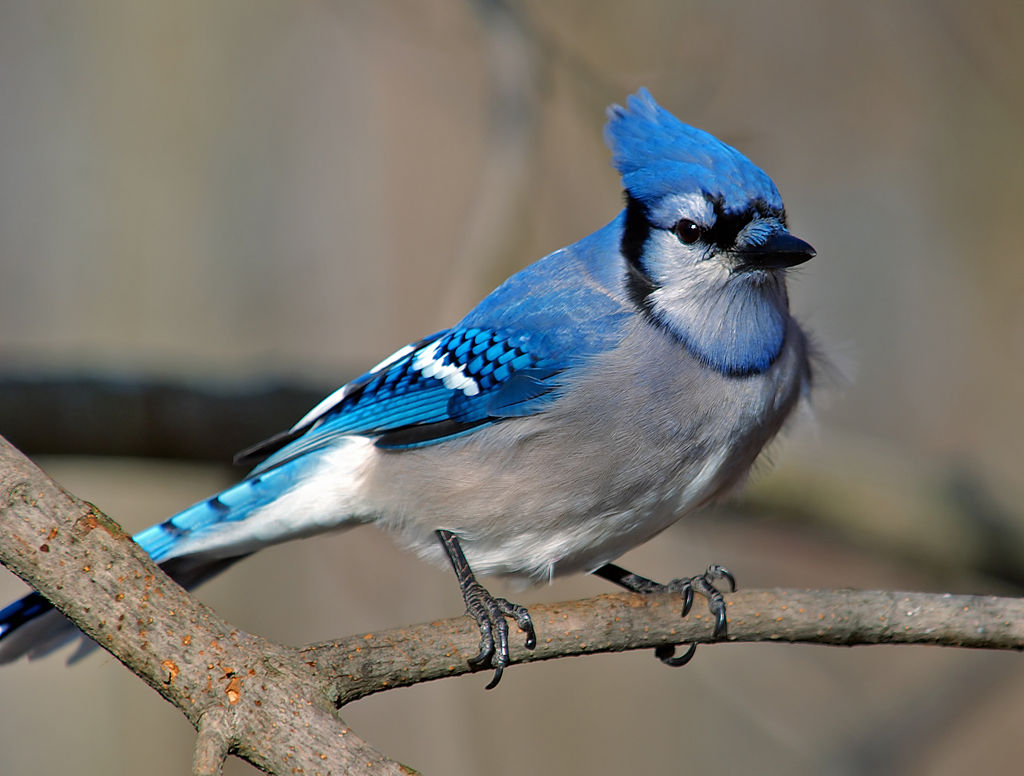
Coloration and Markings: Blue Jays have lovely blue backs, with medium-length blue wings which display a prominent white wingbar, outlined in black, on each. You will also see a pattern of scaling, with black-outlined light-blue spots throughout the length and the occasional large, white spots. The long and broad tails are more symmetrical, having a pattern of light blue rectangles on each side as well as white outer feathers. The underbelly and breast of this bird are a crisp white and facially, you’ll notice the beautiful and large blue crest as well as a black line at its termination in the back, which goes down the face and circles at the base of the neck to travel to the other side. The remainder of the face is white excepting only the birds thin, abstract black mask and it’s long, straight black bill.
Size: These birds measure in at 9.8 – 11.8 inches in length and have wingspans of 13.4 to 16.9 inches wide. That’s a whole lot of beautiful bird, folks!
Habitat: Blue Jays like to spend their time at the forest;s edge and in forest clearings, where they are often found near Oak trees. Jays like to get the acrorns and smash them open for the goodness inside, so if you see some Oaks nearby then keep an eye open… A Blue Jay might well be nearby.
Diet: Blue Jays love suet but they have trouble getting to it unless you affix it to a tree. They are also fond of crushed peanuts and Black Oil Sunflower seeds as well so be sure to leave out plenty. This is one bird that you never get tired of seeing.
New Jersey Bird Buffet
With over 480 different species you are going to want to play a little with the types of seed and other foods that you leave out in your feeder. This will help you to get a little idea of which birds that you will be attracting so that things don’t just get chaotic out there. To that effect, we’ve got some recommendations from the Mendham Garden center as well as a few of our own for maximizing the amount of birds that you might attract. Give one or more of these recommendations a try and be sure to stock up on the favorites of the birds that you are hoping to lure in. With a little luck and a lot of tweaking you might be able to get the ones that you want! If you’d like to see that article from Mendham Garden Center just be sure to check our references and in the meantime give some of these a try:
- Shelled or Cracked Corn
- Black Oil Sunflower
- Nyjer thistle
- Grape jelly
- Safflower seeds
- Raisins
New Jersey Birding Hot Spots
If you are looking to see the winged celebrities of New Jersey in their native element then the Chirparazzi have some great information to share. Below we’ve got some of the hotspots where you can see and maybe even photograph some of your favorite feathered friends. If you don’t see something close, however, don’t worry as the included link will let you many a wonderful place that is sure to be close to home. In the meantime, here are some spots at the compass points to get you started on planning your day-trip:
- Northern hotspot – Ogden Mine Railroad Path
- Eastern hotspot – Sandy Hook Multi-Use Pathway
- Southern hotspot – North Wildwood Seawall Trail
- Western hotspot – Cooper River Park
- Central hotspot – Pemberton Rail-Trail
Detailed descriptions of each location as well as information regarding visiting and what birds you can see at these locations may be found at https://www.traillink.com/stateactivity/nj-birding-trails/
Some Final Words
Today we’ve talked about the popular backyard birds of New Jersey and as you can see, you’ve got quite a lot to choose from. While we have only discussed a sampling we hope that this will be enough to get you started so that your feeders are ready and well-stocked to try and lure the birds that you are hoping to see. Just remember to be patient, as these little feathered celebrities can be quite fickle, and keep your camera nearby just in case so that you can share those photos. Until next time, we wish you our birding best!
